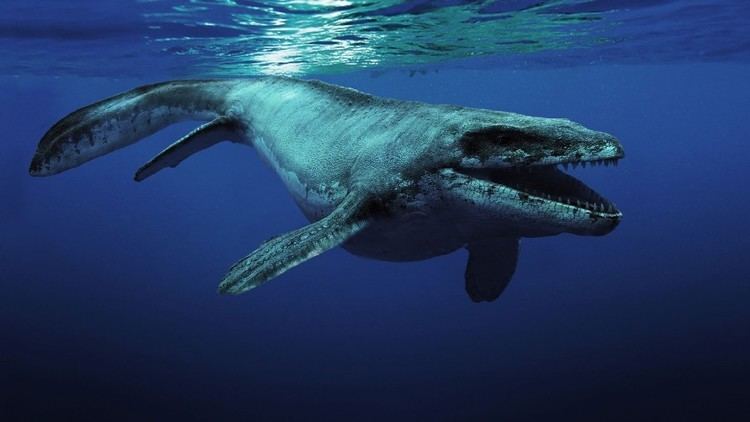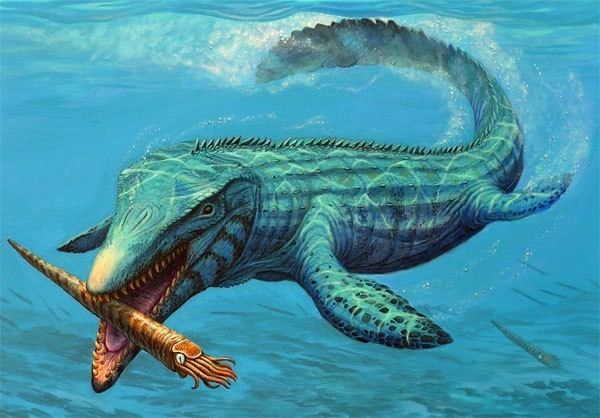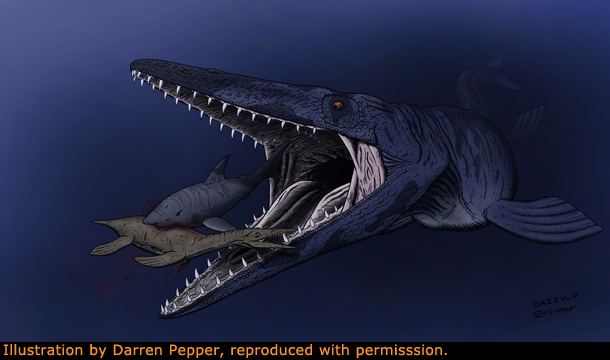Kingdom Animalia Order Squamata Family †Mosasauridae Scientific name Mosasaurus Rank Genus | Phylum Chordata Superfamily †Mosasauroidea Tribe †Mosasaurini Higher classification Mosasaurini | |
 | ||
Similar Megalodon, Spinosaurus, Placoderm fish, Velociraptor, Tylosaurus | ||
Dinosaur fight mosasaurus vs megalodon battle marine reptiles kids dino superfunreviews
Mosasaurus (/ˌmoʊzəˈsɔːrəs/; "lizard of the Meuse River") is a genus of mosasaurs, extinct carnivorous aquatic lizards. It existed during the Maastrichtian age of the late Cretaceous period, between about 70 and 66 million years ago, in western Europe and North America. The name means "Meuse lizard", as the first specimen was found near the Meuse River (Latin Mosa + Greek sauros lizard).
Contents
- Dinosaur fight mosasaurus vs megalodon battle marine reptiles kids dino superfunreviews
- Dinosaur box 13 toy collection marine reptiles mosasaurus unboxing toy review superfunreviews
- Description
- First discoveries
- Identification as an extinct reptile
- Classification and species
- Misassigned species junior synonyms and nomina dubia
- References

Dinosaur box 13 toy collection marine reptiles mosasaurus unboxing toy review superfunreviews
Description

Mosasaurus was among the last of the mosasaurids, and among the largest. As with most mosasaurids, the legs and feet of Mosasaurus were modified into flippers, and the front flippers were larger than the hind flippers. The largest known species, M. hoffmannii reached lengths up to 17 m (56 ft), slightly longer than its relatives Tylosaurus and Hainosaurus. Mosasaurus was also more robust than related mosasaurids. The skull was more robust than in other mosasaurids, and the lower jaws (mandibles) attached very tightly to the skull. They had deep, barrel-shaped bodies, and with their fairly large eyes, poor binocular vision, and poorly developed olfactory bulbs, experts believe that Mosasaurus lived near the ocean surface, where they preyed on fish, turtles, ammonites, smaller mosasaurs, birds, pterosaurs, and plesiosaurs. Although they were able to dive, they evidently did not venture into deeper waters.

The skull of Mosasaurus tapered off into a short, conical tip. The jaws were armed with massive conical teeth. Their paddle-like limbs had five digits in front and four in back. The body ended in a strong tail, which other mosasaurid fossils suggest had a fluke similar to those of sharks and some ichthyosaurs. The body probably remained stiff to reduce drag through the water, while the end of the tail provided strong propulsion.
First discoveries
Mosasaurus was the first genus of mosasaurs to be named. The first remains known to science were a fragmentary skull from a chalk quarry in the St Pietersberg, a hill near Maastricht, the Netherlands, found in 1764 and collected by lieutenant Jean Baptiste Drouin in 1766. It was procured for the Teylers Museum at Haarlem in 1784 by Martinus van Marum, the first director of the museum, who published its description only in 1790. He considered it to be a species of "big breathing fish" (Pisces cetacei, in other words: a whale). It is still part of the collection as TM 7424.
At some time between 1770 and 1774 ("1770" according to Faujas de Saint-Fond, "about the year 1770" according to Camper and "en 1780" according to Cuvier in 1808) a second partial skull was discovered and procured. It was found in the ground owned by canon Theodorus Joannes Godding, who displayed it in his country house on the slope of the hill. A local retired German/Dutch army physician, Johann Leonard Hoffmann (1710–1782), also collected some fragments and corresponded about the skull with the Dutch Professor Petrus Camper. Hoffmann presumed the animal was a crocodile. In 1786 however, Camper disagreed and concluded the remains were those of "an unknown toothed whale".
Maastricht, an important fortress city, was captured by the French revolutionary armies by the end of 1794. Accompanying the French troops, although arriving in Maastricht two months after the city had been taken, was geologist Barthélemy Faujas de Saint-Fond on a mission to secure the piece, together with représentant du peuple (political commissar) Augustin-Lucie de Frécine (1751–1804), who during the campaign tried to transport anything of artistic or scientific value he could lay his hands on to France. Finding that it had been removed from the cottage and hidden within the fortress, Frécine supposedly offered "six hundred bottles of excellent wine" to those being the first to locate the skull and bring it to him in one piece. Soon, a dozen grenadiers claimed their reward, carrying the piece with them. December 1794 it was moved to Paris as war booty, by decree declared a national heritage and added to the collection of the new Muséum national d'Histoire naturelle.
In 1798 Faujas de Saint-Fond published his Histoire naturelle de la montagne de Saint-Pierre de Maestricht [Tome 1], which also contained an account of the circumstances of the find. According to him, Dr. Hoffmann paid the quarrymen to inform him of any fossil finds. When the skull was found in 1770 Hoffmann was notified by the quarrymen and he is said to have led the excavation from then on. Afterwards, Godding would have claimed his rights as landowner and forced Hoffmann to relinquish his ownership through a lawsuit, won by influencing the court. De Saint-Fond, after all, in 1795, saved the specimen for science, promising a considerable indemnity to Godding to compensate for his loss. However, as Dutch historian Peggy Rompen has illustrated, very little of this famous story can be substantiated by other sources. Godding was the original owner, Hoffmann clearly never possessed the fossil, there is no trace of any lawsuit, Faujas de Saint-Fond probably never paid anything, and the entire account seems to have been fabricated by him to justify the dispossession by military force.
Identification as an extinct reptile
De Saint-Fond still assumed the specimen represented a crocodile. In 1798 the son of Petrus Camper, Adriaan Gilles Camper, again studied the fossil indirectly by reconsidering the description by his father. He was the first to reach the conclusion that the remains were those of a giant monitor, which result in 1799 he corresponded to Georges Cuvier.
In 1808 Cuvier confirmed Camper's result. The fossil had already become part of Cuvier's first speculations on the possibility of animal species going extinct. The idea of extinction paved the way for his theory of catastrophism or "consecutive creations", one of the predecessors of the evolution theory. Prior to this, almost all fossil reptile specimens, when recognized as having come from once-living animals, were interpreted as forms similar to those of the modern day: crocodiles, fish, whales, or large land mammals. Cuvier's idea that the Maastricht specimen was a gigantic version of a modern animal unlike any species alive today seemed strange, even to him. He justified this by trusting his techniques in the then-developing field of comparative anatomy, which he had already used to identify giant, extinct members of other modern groups known only from fossils, including giant tapir and ground sloth specimens.
A scientific name had not yet been given to the new species, the specimen usually being referred to as the Grand Animal fossile des Carrières de Maëstricht or "Great Fossil Animal of the Maastricht quarries". In 1822 William Daniel Conybeare named it Mosasaurus after the Latin name (Mosa) of the Maas (Meuse) River passing along Mount Saint Peter, the second skull being the holotype, MNHNP AC9648. The specific name (epithet) hoffmannii was added by Gideon Mantell in 1829, honouring Hoffmann, on the presumption he was the discoverer of the type specimen. The emendated form hoffmanni often used today, is contrary to the rules of the ICZN that state "the original spelling of a name [...] is to be preserved."
In 1854 German biologist Hermann Schlegel was the first to conjecture Mosasaurus had flippers instead of normal feet.
On September 19, 2012, it was announced that nine days earlier, again a skeleton of what appears to be a Mosasaur was found in the limestone quarry just outside Maastricht, the same quarry that yielded the type specimen of Mosasaurus hoffmannii. Carlo Brauer, an excavator operator at the ENCI quarry, discovered the teeth of the fossil in the shovel of his digger on Monday morning, September 10. In the days following the discovery, museum staff retrieved several large sections of the skull and part of the body and tail of the approximately 13-metre long skeleton. Based on stratigraphy, the age of the specimen was estimated at 67.83 million years, making it about one-and-a-half million years older than "Bèr". From what has been uncovered, this appears to be the oldest known specimen of Mosasaurus hoffmannii or a closely related species. The specimen is nicknamed Carlo, after the ENCI worker who discovered it.
On Saturday, April 18, 2015, a fourteen-year-old amateur paleontologist, Lars Barten, from Rijkevoort village in Noord-Brabant province in the Netherlands, together with his father Jos Barten, discovered a Mosasaurus hoffmani fossil near ENCI-Maastricht. The fossil has been named Lars, after its finder and now resides in the Natuurhistorisch Museum Maastricht (Maastricht Natural History Museum).
Classification and species
The family Mosasauridae is split into several subfamilies, with Mosasaurus being placed within Mosasaurinae. This subfamily, in turn, is further split into smaller tribes, with Mosasaurus being grouped with Clidastes, Moanasaurus, and Liodon in the tribe Mosasaurini.
Since the genus was first named in the early 19th century, numerous species have been assigned to Mosasaurus, both from North America and Europe. Many researchers have suggested that certain European species are actually synonyms of their American counterparts, though because many of the specimens involved are incomplete, scientists have gone back and forth regarding which species are synonyms and which are not. For example, the giant American species M. maximus is regarded by most researchers as a junior synonym of the European M. hoffmannii, though a few scientists maintain that the two can be distinguished by features of their skull bones.
Five species are generally recognized as valid today: M. hoffmannii Mantell, 1829 (the type species), M. conodon Cope, 1881,M. lemonnieri Dollo, 1889, M. beaugei Arambourg, 1952, and M. missouriensis (Harlan, 1834).
Cladogram of mosasaurs and related taxa modified from D.V. Grigoriev, 2013:
